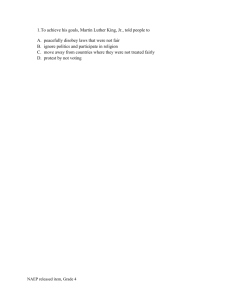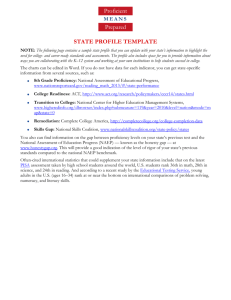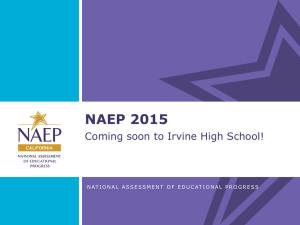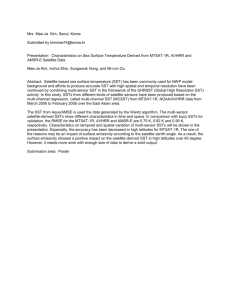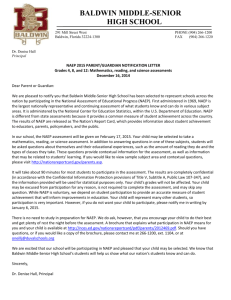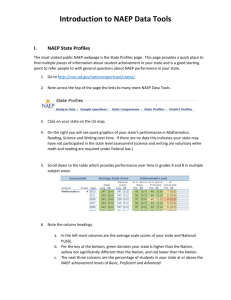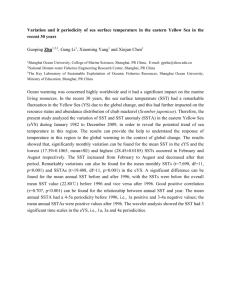Stephanie Wood-Garnett - District of Columbia State Improvement
advertisement
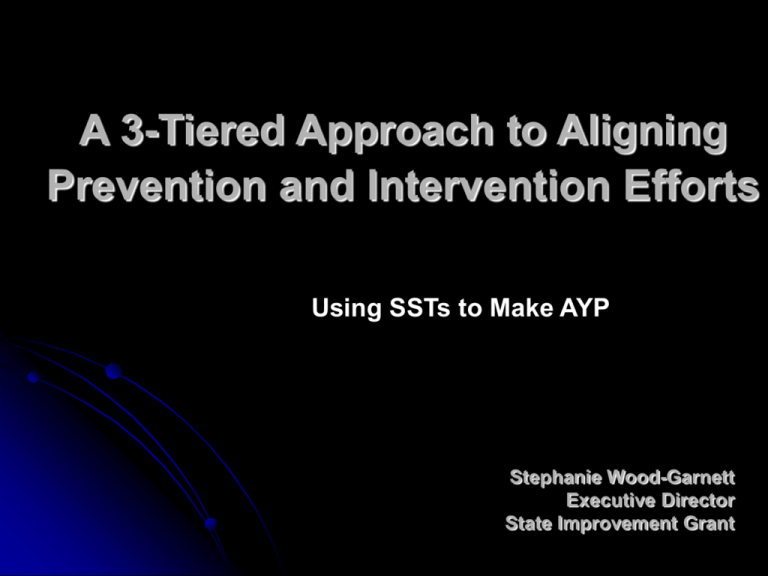
A 3-Tiered Approach to Aligning Prevention and Intervention Efforts Using SSTs to Make AYP Stephanie Wood-Garnett Executive Director State Improvement Grant PURPOSE Develop a common foundation for discussing evidence-based intervention Discuss intervention/prevention research Review and discuss the Student Support Team (SST) process OUR GOAL: LEAVE NO CHILD BEHIND Schools must have strong systems focused on proactive and preventative strategies designed to meet the needs of a diverse student population. Classrooms and non-classroom settings need to be places where a range of student abilities are supported. Use the SST Process to Help More Students Acquire the Target Skills… ~5% Academics and Behaviors ~15% Primary Prevention: School-/ClassroomWide Systems for All Students, Staff, & Settings ~80% of Students Tertiary Prevention: Specialized Individualized *Systems for Students with High-Risk Behavior Secondary Prevention: Targeted Interventions *Systems for Students with At-Risk Behavior Rosenfeld, 1989 School Environment Instructional Level Student Curriculum Home Environment Instruction Community Environment Red, Yellow, or Green? Lavar Arrington Darrell Green Dexter Manley Tim Duncan Kobe Bryant Allen Iverson Martha Stewart Oprah Winphrey Howard Stern What % of Your Students Are… Academics Behavior % Green Zone % Green Zone % Yellow Zone % Yellow Zone % Red Zone % Red Zone In Your School, What Do You Offer Kids Who Can’t/Won’t Do What You Need to Improve? Intervention Primary Secondary Tertiary # of students involved Who is responsible? What is working? What isn’t working? Reach Me Teach Me… Why Your Building Needs SSTs to Support School Improvement Research Shows… All students regardless of socioeconomic status– need sustained support to succeed. James Comer, School Development Program, Yale University Research Shows… Studies indicate that for African American and Latino students, positive teacherstudent relationships greatly impact student achievement (Baker, 1999; Lee, 1999; Slaughter-Defoe & Carlson, 1996). Research Shows… “No significant learning occurs without a significant relationship” James Comer Yale University Research Shows… By high school, nearly 40-60% of all students are chronically disengaged from school (Klem and Connell, 2004). Research Shows… Students who are connected to school are less likely to: Use substances Exhibit emotional distress Demonstrate deviant/destructive behavior Experience suicidal thoughts/attempt suicide Become pregnant Skip school Engage in bullying/fighting/vandalism (Lonczak, Abbot, Hawkins, Kosterman & Catalano, 2002; Samdal, Nutbeam, Wold & Kannas, 1998; Schapps, 2003; Wilson & Elliott, 2003). Research Shows… In order to increase school-student connections: Implement high standards Provide academic supports to all students Implement fair/consistent discipline policies Create trusting relationships (in-school and school-home) Support teachers in using new instructional strategies and implementing classroom management Foster high parent/family expectations Ensure that students feel close to at least one adult in the school building Center for Disease Control and Prevention, Division of Adolescent and School Health &University of MN, 2003) Every Child a Reader by Third Grade A vision or a reality? Proliferation of Reading Research Research Shows… Rate of reading failure for African Americans, Hispanics, limited English speakers, and poor children ranges is 60% (70% in urban areas). National Institute of Child Health and Human Development Research Shows… Approximately 50% of children and adolescents with a history of substance abuse have reading problems. Research Shows… Almost seven thousand students drop out of high school every school day (Alliance for Excellent Education, 2006). Of the children who will eventually drop out of school, >75% report reading difficulties (National Institute of Child Health and Human Development) The students lack the literacy skills to keep up with the high school curriculum (Kamil, 2003; Snow & Biancarosa, 2003). Research Shows… The bulk of older struggling readers and writers can read, but cannot understand what they read (Alliance for Excellent Education, 2006). 2005 NAEP Grade 4 Reading by Race/Ethnicity, Nation 100% Percent of Students 13 15 18 40 80% 29 40 29 30 60% 32 40% 59 35 56 Proficient/Advanced Basic Below Basic 51 20% 28 25 0% African American Asian Latino Native American White Source: National Center for Education Statistics, NAEP Data Explorer, http://nces.ed.gov/nationsreportcard/nde/ 2005 NAEP Grade 4 Reading by Family Income, Nation 100% Percent of Students 15 80% 42 30 60% 35 40% Proficient/Advanced Basic Below Basic 54 20% 23 0% Poor Non-Poor Source: National Center for Education Statistics, NAEP Data Explorer, http://nces.ed.gov/nationsreportcard/nde/ 2005 NAEP Grade 8 Math by Race/Ethnicity, Nation Percent of Students 100% 80% 9 33 13 37 47 38 60% 40% 15 41 42 34 59 50 20% Proficient/Advanced Basic Below Basic 45 21 19 0% African American Asian Latino Native American White Source: National Center for Education Statistics, NAEP Data Explorer, http://nces.ed.gov/nationsreportcard/nde/ 2005 NAEP Grade 8 Math by Family Income, Nation 100% Percent of Students 13 38 80% 38 60% 41 40% 20% Proficient/Advanced Basic Below Basic 49 21 0% Poor Non-Poor Source: National Center for Education Statistics, NAEP Data Explorer, http://nces.ed.gov/nationsreportcard/nde/ Students who remain in school but continue to struggle are often placed in a variety of educational programs Special Education Referrals Academic problems (primarily reading deficiencies) Behavioral problems Donovan & Cross, 2002; Learning Disabilities Association of America, 1996; Ysseldyke, Vanderwood & Shriner, 1997) INDIVIDUALS WITH DISABILITIES EDUCATION IMPROVEMENT ACT (2004) Reflects heightened intensity that we must do more before referring children to special education. IDEA 2004 In making a determination of eligibility under Section 614(b)(4)(A) of IDEA: a child shall not be determined to be a child with a disability if the determinant factor for such determination is lack of appropriate instruction in reading, including in the essential components of reading instruction (as defined in Section 1208(3) of ESEA); lack of instruction in math; or limited English proficiency. [614(b)(5) of IDEA]. INTERVENTION “IDEA”S Response to Intervention (RTI) Early Intervening Services (EIS) Disproportionality DCPS Referrals by Grade Level: 2004 - 2005 AFRICAN AMERICAN STUDENTS IN SPECIAL EDUCATION African American students: 2.9 times as likely to be labeled mentally retarded (MR) 1.9 times as likely to labeled seriously emotionally disturbed (SED) 1.3 times as likely to be labeled as having a learning disability (LD) U.S. Department of Education, Office of Special Education Programs (2000) BOYS OVER-REPRESENTED 1.9 million girls and 3.8 million boys are classified as special education (U.S. Department of Education, Office for Civil Rights, 2000) Boys dominate the emotionally disturbed category: 90% in Kansas City 55% in Milwaukee 76% in Washington, DC What Do We Know About… TEAM Together Everybody Achieves More… The Student Support Team Process SSTs: 30 YEARS IN THE MAKING Began as a special education mandate in the 1975 Education for all Handicapped Children Act which required the use of multidisciplinary teams in the referral/placement process (Rosenfeld & Gravois, 1999). The function and purpose of SSTs changed as schools and families discovered the benefits of intervening earlier for students. By 1979 Chalfant and colleagues developed Teacher Assistance Teams (Safran,1996). Currently most states require some form of intervention prior to special education referral: 69% of states mandate prereferral intervention teams 86% of states require or recommend pre-referral intervention teams (Truscott, Cohen, Sams, Sanborn & Frank, 2005) IMPACT OF EFFECTIVE SSTS Improve academic achievement Improve student behavior (including school attendance) Improve school-parental communication and relationships Increase collaboration in schools Reduce referrals to special education PURPOSE AND FUNCTION OF SSTS SST is not to “operate as a special education eligibility or placement committee” (NABSE and ILIAD Project, 2002, p. 19). SST is NOT meant to deny services to students who may actually have a disability. SSTs should NOT assume the difficulty lies solely within the child. SST PROCEDURES Individual interventions Group interventions Meeting occurrence (frequency/duration) Variations in implementation Elementary school Middle/Junior High school High school SST PROCEDURES Use data in all discussions Establish positive student goals Align interventions with the desired results Review student progress regularly Set measurable outcomes Include evaluation measures CONTACT INFORMATION Stephanie Wood-Garnett Executive Director, State Improvement Grant District of Columbia Public Schools www.dcsig.org Stephanie.Garnett@k12.dc.us 202-442-5539
